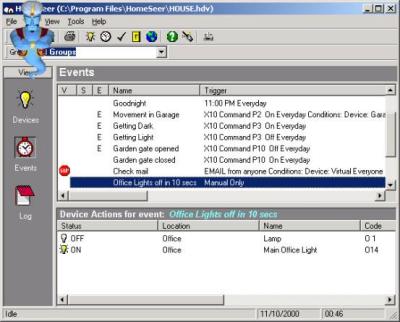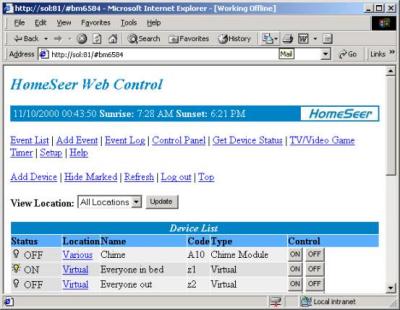
Overview – Homeseer is home automation software produced by Keware Technologies. It connects to a standard UK CM12U PC controller without any problem, and allows X10 commands to be sent and received from various devices. A 30 day demo of Homeseer is available from the Homeseer web site and the full registered version is currently priced around £50.
Although to get the best out of Homeseer, you’ll need to run a PC 24/7, this isn’t necessary for simple timing tasks. Homeseer has the ability to download events into the CM12U (you need to purchase an additional software module to do this), which will then be executed by the CM12U at the relevant time. However, for my part, I keep the home automation machine on 24 hours, and as such haven’t tested downloading events to the CM12U.

Devices – In it’s simplest form, Homeseer allows you to add your X10 devices to it’s “devices” page, and control each device with a click of the mouse – This includes such X10 commands as pre-set DIM and status request (assuming the device supports it of course!).
Devices may be assigned to locations (“Front room” for example), and a drop down list of device types is also available. Homeseer comes with a number of pre-defined device types, however adding and deleting device types is easily achieved via the “options” page. Setting device types simply allows device characteristics to be automatically set when you add a new device (for example, for an X10 PIR you could tick the “status only” check box, and any X10 PIRs you add will automatically have this setting).
The X10 address needs to be selected for each device, with the unusual option of being able to set house codes greater than “P”. While this may initially sound useless, it is in fact quite handy for creating “virtual devices”, which can be used for storing X10 codes. An example of this would be to create a virtual “any movement” device on “z1”, and create an event (more about those later) which sets “z1” when any of your PIRs detect movement. In this way, you only have to check the status of one X10 address if you want to detect for movement “somewhere in or around the house”.
Just so you don’t get too confused, all house codes greater that “P” are listed in lower case, so there’s no confusion as to what are virtual devices, and what are real devices.

Events – However, Homeseer is much more than just a list of devices. It also contains an “Events” page which allows (surprise, surprise) events to be created.
Events are basically a command or list of commands which get triggered when “something” happens. In Homeseer, that “something” can be an X10 device changing state, a time of day, sunset/sunrise (assuming you set the longitude and latitude correctly), or any number of different actions (which even includes receiving e-mail).
Events are one of the features that makes Homeseer so powerful. It allows X10 macros to be easily created, and even allows the PC to “talk” when something happens (“It’s getting dark, I’ll turn the lights on” for example!).
Events can also trigger VBScript code, send e-mails, run other events, or do pretty much anything you’re ever lightly to want to do!
Voice output and voice recognition Homeseer uses Microsoft “Agents” for voice output (anyone not familiar with MS-Agents should visit http://www.microsoft.com/msagent/ – Basically they’re little cartoon characters which sit on your desktop, and talk to you on request). Homeseer also interfaces with the Microsoft voice recognition engine, which should enable events to be triggered when spoken commands are received. This is something which I haven’t set-up, although I have briefly played with it, and did successfully have my lights going on and off to voice commands!

Web Server – Control of Homeseer is via one of two methods. One the machine running Homeseer, the program itself can obviously be used, however I’m sure many people use a set-up similar to my own, and use a different PC for their home automation tasks. This is where the built-in web server comes into it’s own. Almost any task which you can do on the console can be achieved remotely via the web server. This doesn’t necessary mean accessing your machine via the Internet (although, there is no reason why you shouldn’t if you’re lucky enough to have an always on Internet connection), but more important, at least in my opinion, is the ability to control Homeseer from a PC connected via a network to the server (AKA an Intranet). The web pages themselves are not particularly configurable (other than titles and colours), but this isn’t necessary a problem.
IR Control IR devices can also be controlled via Homeseer, although as I don’t use X10 for IR control I can’t comment on this aspect of the software
Support Support for Homeseer appears to be very good. I have rarely had the need to e-mail their support directly, however on the one or two occasions I have, I have always had a response within 24 hours.
For The Programmer – One of the nicest features of Homeseer is the ability to run VBScript programs when events are triggered. In this way, you can create an event that is activated when, for example, H4 changes state, and then run the associated piece of VBScript.
Excuse me if I go into “techy” mode for a moment, but this ability is really what makes Homeseer my software of choice. I use a Meteor CallerID box for telephone logging, and have written software which logs all incoming and outgoing calls to an Access database (as well as announcing the caller over ceiling speakers of course!). The ability to use VBScript (and hence ADO) in Homeseer allows me to read the Access database on an X10 event. The upshot of all this, is that my home automation system will now automatically tell me about any telephone calls I missed whilst I was out of the house. It also means that I can create an event on an address code that reads back the last incoming calls – This can then be activated by pressing “on” on the associated X10 switch, and the list stopped by pressed “off”. Incidentally, I keep thinking I should neaten this CallerID software up a little and make some half-hearted attempt to market it! – I would be interested to hear anyone’s views on this!
In its simplest form, VBScript is a very easy language to learn, and Homeseer has a number of build in methods which allow various home automation tasks to be executed. For example, a VBScript program to speak when a light goes on is as simple as:
If (hs.isOn(“H1”)) then
Hs.speak (“the light is on”)
End if
ActiveX Server
Homeseer is also allegedly an ActiveX server, which in theory means that you can write software in VB, or Delphi, or any COM compliant development tool that can access all the features of Homeseer.
I say “allegedly” because I haven’t yet got this working! – One of the problems with Homeseer is that the only way of controlling the software from another PC is via the built-in web server – And as I’m sure may people use a different PC for home automation than the machine they use for everyday use, this is quite an important feature.
However, I wanted to create my own web pages that interfaced directly with Homeseer (the default web pages, whist comprehensive, were too comprehensive for what I had in mind). You can run multiple web servers on the same machine by simple selected a different TCP/IP port for the server to run on. In my case, my Home Automation PC is also my file server, and is running Windows 2000 Server with IIS5 installed for other web work I do for a living. I configured the Homeseer web server to run on port 81, which allows both web servers to run concurrently.
Because I used ASP extensively for work, I decided that I would create an ASP page on the IIS5 web server, which talked to Homeseer via COM. However, I could never get this to work, it appears that Homeseer creates another instance of itself when a COM “createObject” (or getObject) is called. From reading some of the Homeseer support web pages, it appears this is a common problem, and as far as I know, no one has yet found a way around this (if anyone finds out, please let me know!).
I suspect this is more a security issue with IIS5 rather than a problem with Homeseer, and whist I haven’t had the need to try the Homeseer ActiveX server via a Delphi program, I see no reason why that shouldn’t work (although, I wonder what the point would be!). DCOM should also therefore be possible.
Conclusion – I would have no hesitation in recommending Homeseer to anyone who is looking for a PC control solution to their X10 home automation system. Initially I was planning on using Homeseer until I could justify the cost of a “more sophisticated” solution such as HomeVision. However, the more I use Homeseer, the more convinced I am that it meets virtually all of the requirements I have from a home automation control system. I feel it would be unfair for me to pit Homeseer directly against HomeVision for the simple reason I have never spent a great deal of time playing with a HomeVision system, however the flexibility of Homeseer, and particularly the ability to create VBScript events, mean that I’ll certainly be sticking with Homeseer for the foreseeable.
My impression is that if you have an incline to dabble with VBScript, and some of the more “in depth” aspects of Homeseer, then you can’t go wrong, however if you’re happier with the more “menu driven” configuration of HomeVision, and don’t want to leave a PC on 24/7, then go with HomeVision.
Another aspect is of course the cost. I was lucky in as much as I had a PC acting as a server already (and MP3 jukebox, and CallerID box!). As such, the cost of Homeseer to me was simply the cost of registration, and the cost of the CM12U. I suspect I would have gone down the HomeVision route had I need to buy a new PC for home automation. Although all said and done, I wouldn’t be without it now!
And as a final point, I feel I should point out that I have no affiliation with Homeseer whatsoever! – No, I’m not on commission (although maybe I should be :-)!
Approximate Price £100. Available From HomeSeer
Want More? – Follow us on Twitter, Like us on Facebook, or subscribe to our RSS feed. You can even get these news stories delivered via email, straight to your inbox every day

Be the first to comment on "HomeSeer – Review"